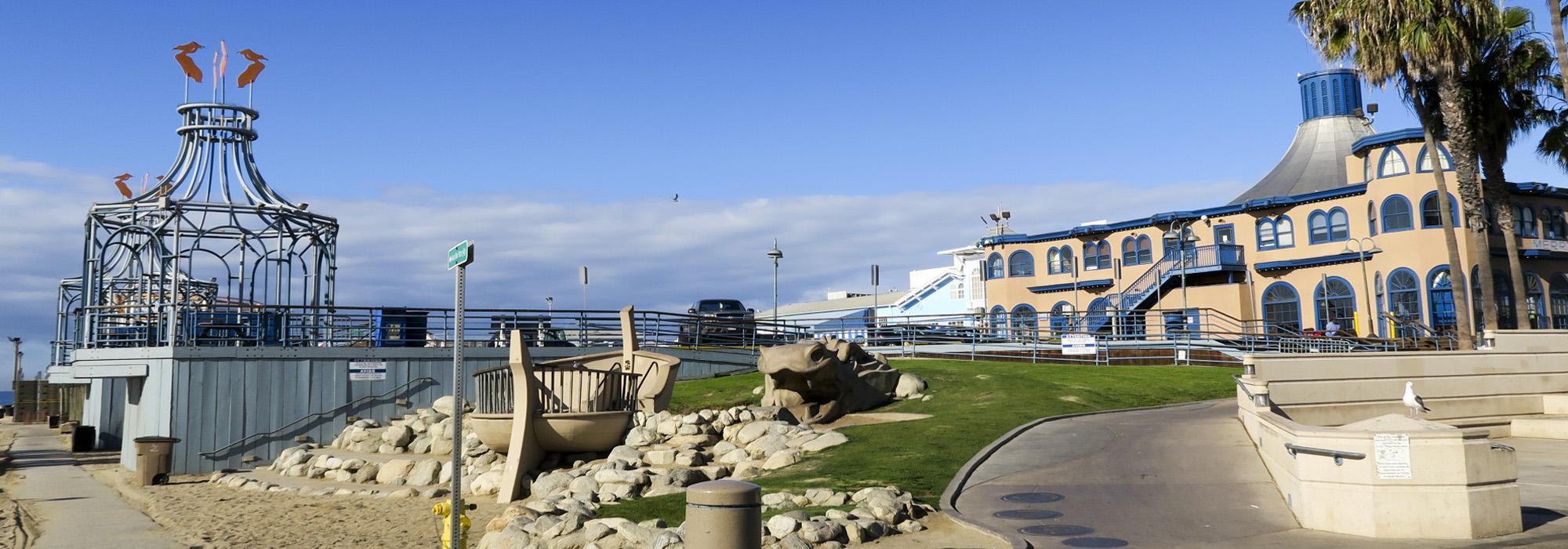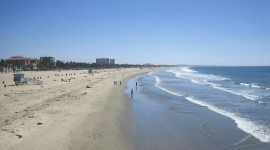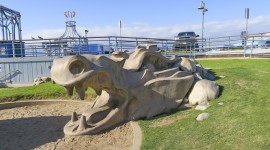Santa Monica’s Carousel Park Faces Imminent Threat
The City of Santa Monica, along with the California Department of Transportation (Caltrans) and the Federal Highway Administration (FHWA), is proposing to replace the Santa Monica Pier Bridge, which has been deemed structurally deficient. The current bridge extends west from the intersection of Ocean Avenue and Colorado Avenue to the Santa Monica Pier. In November 2017, Caltrans and the City of Santa Monica issued a Draft Environmental Impact Report/Environmental Assessment (DEIR/EA), which presented three alternative plans for replacing the bridge with a new structure. Two of the three alternatives would effectively dismantle Carousel Park, a culturally significant Postmodernist landscape designed by the architectural firm Moore Ruble Yudell and the landscape-architectural firm Campbell & Campbell.
HISTORY
The history of the Santa Monica Pier begins in 1909 when the Santa Monica Municipal Pier was built to carry wastewater into the Pacific Ocean. A second pier, the Looff Pleasure Pier, was constructed in 1916 immediately to the south of the first and along with it became known as the Santa Monica Pier. The Carousel Building was constructed one year later by Charles I.C. Looff to house the first carousel, which was replaced by another carousel in 1922. The latter is still extant. Upon their construction, the pier and the Carousel Building immediately contributed to an ensemble that included the “The Promenade” (today known as Ocean Front Walk), which had been paved in 1907, providing a venue for leisurely seaside strolls. Tourists and residents alike flocked to the newly built amenities, which remained popular attractions through the mid-twentieth century. Although the area languished with a decrease in visitation beginning in the late 1950s, public support for the Santa Monica Pier was clearly demonstrated in 1973 when plans to demolish it were averted by strong public protests and action led by the local group Save Our Pier Forever.
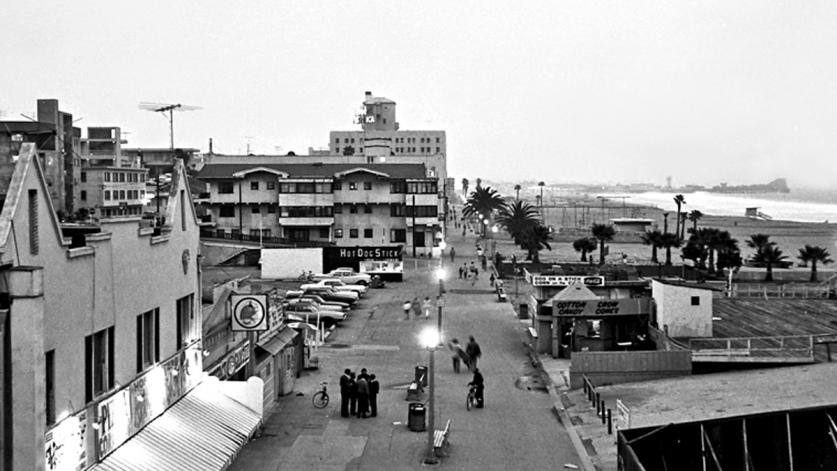
In the mid-1980s, architects Moore Ruble Yudell worked on a waterfront redevelopment plan that created Carousel Park, located just east of the pier and named for the antique carousel displayed near the pier’s entrance. Designed in concert with landscape architects Campbell & Campbell, the park features a stepped, octagonal entryway with poured-in-place light standards, an enlarged deck around the carousel, and a pavilion. A 5,000-square-foot children’s playground occupies the southern edge of the site, which includes a custom-made concrete ship and a dragon sculpted from river-washed granite boulders. Two generous ramps provide access from Ocean Front Walk to the deck of the pier. To the south, a large wood-plank amphitheater and wood-plank stairs give access from the beach to the pier deck, flanked by two octagonal towers that echo architectural elements of the Carousel Building. Today the pier includes Pacific Park, a family-oriented amusement park with a large Ferris wheel, the Santa Monica Pier Aquarium, numerous commercial and entertainment venues, and a space dedicated to fishing at the end of the pier. Carousel Park is also a key element of the larger landscape and recreational area that extends south from the Santa Monica Pier to the Ocean Park neighborhood.

The work by Moore Ruble Yudell and Campbell & Campbell marked the beginning of a renewed interest in the pier and a new era in its history, with Carousel Park heralded as an unqualified success. The project won several awards, including an official commendation from the mayor of the City of Santa Monica (1987). The book Waterfronts: Cities Reclaim Their Edge, by Ann Breen and Dick Rigby, says the following about Carousel Park: “What has been accomplished at Carousel Park is first-rate design, capturing architectural details and reflecting the area’s landscape…”
The team behind the design of Carousel Park is equally esteemed. Moore Ruble Yudell is an architectural firm with an international presence. Founded in 1977 by Charles Moore, John Ruble, and Buzz Yudell, the firm has been highly lauded for its many award-winning designs, including that of the U.S. Embassy in Helsinki, Finland, in 2016. Moore is widely recognized as a primary progenitor of Postmodernist design (exemplified by Carousel Park), and his prolific career has been well documented by scholars and historians and includes several books of his own, such as The Poetics of Gardens (1993 with William J. Mitchell and William Turnbull Jr.) and The Chambers for a Memory Palace (1996 with Donlyn Lyndon). He received the Gold Medal from the American Institute of Architects in 1991.
Campbell & Campbell is a landscape-architecture firm with a national presence, based in Santa Barbara, California. The firm was founded in 1983 by Douglas Campbell, ASLA, and Regula Campbell, AIA. Douglas Campbell led the firm’s work at Carousel Park and has been awarded many professional honors. For his work on the park he received the American Society of Landscape Architects, Southern California chapter’s Award of Excellence (1988); the Honor Award from the California Council of the American Institute of Architects (1988); the Honor Award from the Waterfront Center for National Excellence on the Waterfront (1987); and the State of California Department of Rehabilitation Award for Excellence in Barrier-Free Design (1987).
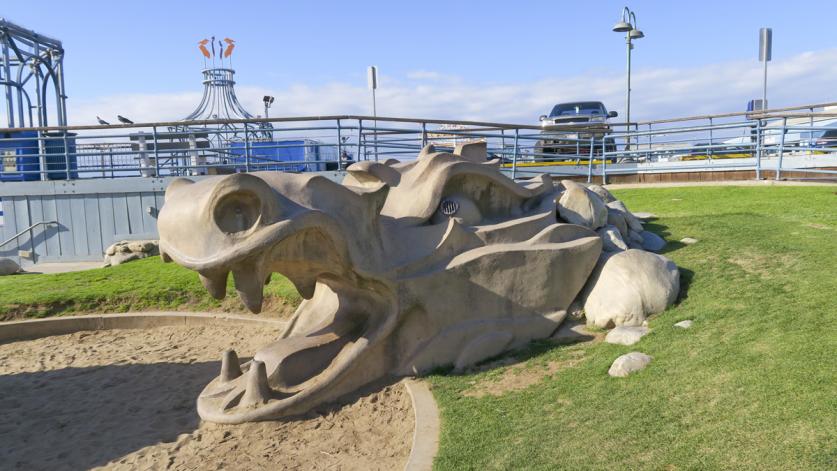
Moreover, Carousel Park was created through a groundbreaking formal design competition whose guidelines, issued in 1982, were established by the Santa Monica Citizen’s Pier Task Force following a year of public meetings. The guidelines mandated that each competing five-member team comprise at least one woman, one member of a minority community, or one physically challenged person. The resulting design, much ahead of its time with regard to issues of ADA standards, reflects the wisdom of that mandate. Indeed, the design guidelines have been called “models for their spirit and sensitivity” (Breen and Rigby, 1993).
THREAT
The DEIR/EA presents three alternative plans for replacing the current Santa Monica Pier Bridge. The first alternative calls for a temporary vehicular-access bridge to be constructed along Moss Avenue, terminating within Carousel Park and necessitating “the removal of some play features at Carousel Park.” The DEIR/EA goes on to say that “the Carousel Park area of the pier would be fully restored to its preconstruction condition” after the temporary-access bridge is removed. The third alternative calls for the Moss Avenue Bridge to be permanent rather than temporary, adding that the bridge’s alignment would “encroach on the Carousel Park area of the pier, which would require reconstruction of similar play features in an area located away from the construction zone or in a nearby area within the boundaries of the Santa Monica Pier parcels prior to construction of the proposed project.” Both Alternative 1 and Alternative 3 would have demonstrable adverse effects on Carousel Park and thus ignore the protection afforded the park under Section 4(f) of the U.S. Department of Transportation Act of 1966. Given that the DEIR/EA purports to address such adverse effects related to Section 4(f) but does not recognize or discuss the park’s significance as a cultural landscape, the DEIR/EA must therefore be regarded in its present form as a fundamentally inadequate assessment.
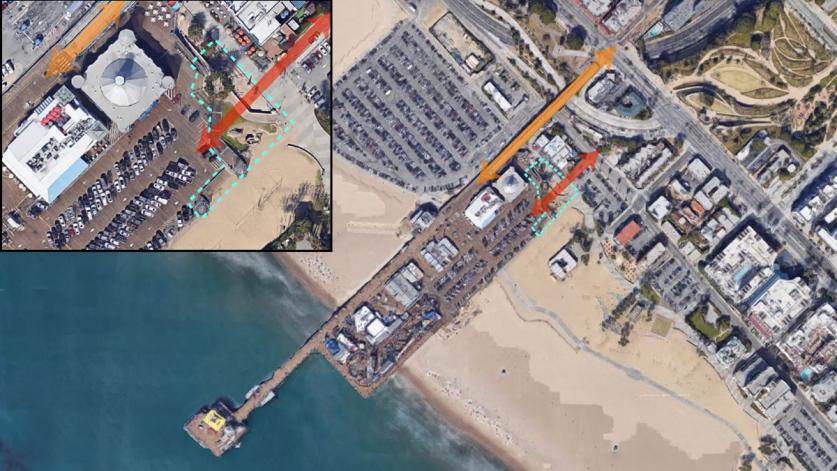
According to its governing legislation enacted in 1966 (and revised in 1968 and 1983), Section 4(f) protects the following basic types of properties: publicly owned park and recreation areas that are open to the general public (emphasis added), publicly owned wildlife and waterfowl refuges, and public or privately owned historic sites. While the DEIR/EA claims that “all Section 4(f) resources in the study area are listed in Table B-1, along with their use status,” neither Carousel Park nor its features are listed in Table B-1 (Appendix B), and there is no discussion of potential adverse effects on the park. Because Carousel Park and its features are entirely omitted from Table B-1 in the DEIR/EA, that document’s further claim that all three build alternatives “would result in a de minimis finding for one Section 4(f) resource, Santa Monica Pier” is demonstrably invalid. Carousel Park is a public park (or at the very least a recreational area) located on city-owned land, and it therefore meets the minimum criteria for consideration under Section 4(f) of the U.S. Department of Transportation Act of 1966.
WHAT'S NEXT
The public comment period on the DEIR/EA has now closed, and The Cultural Landscape Foundation (TCLF) has submitted a formal letter outlining concerns about the project and the validity of the assessment. The final Environmental Impact Report/Environmental Assessment, which will take account of such responses, will be distributed in fall 2018. Meanwhile, TCLF, Chattell, Inc., and the Santa Monica Conservancy have co-sponsored an application to the City of Santa Monica to designate Carousel Park a local Landmark. With its combination of traditional motifs that allude to the historical carousel building and its whimsical, poured-in-place features, the park is a significant exemplar of the Postmodernist style. The park is also historically significant for its role in the renaissance in tourism that came in the wake of the redesigned pier in the mid-1980s. An estimated six million people now visit the pier annually, and the park, along with pier, has clearly contributed to the social and cultural history of Santa Monica. TCLF will continue to publish updates on the fate of the park and the progress of the local Landmark designation.



